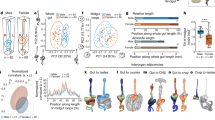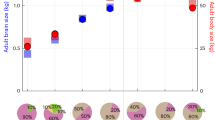Abstract
IT is generally accepted that the neurosecretory cells concerning the metamorphosis of insects contain a small amount of a secretory substance at any time of development1,2, notwithstanding a marked effect which they exert when implanted or transplanted. This means that accumulation of the secretory substance released continuously from the cells in the brain is necessary to become effective. This is the reason why a great many brains were used to extract a sufficient amount of the active principle3. However, we have found that only several devitalized brains of Bombyx mori could cause adult differentiation when inserted into the non-diapausing pupæ of Philosamia cynthia ricini caused to diapause by prompt removal of their brains just after pupation. Devitalization was brought about by various ways such as subjecting brains to freezing in a deep-freezer at −18° C. for 21 days, desiccating them over silica gel for one day, or heating them at 90° C. for 90 min. After being treated, the brains were all proved to be as effective as live ones, so far as they were tested by five for each test pupa. Needless to say that in this case the brain hormone, enough to stimulate adult differentiation of the recipient, had to be present in the five inserted brains. The possibility that the adult differentiation was caused by the prothoracic gland hormone which contaminated the inserted brains can be ruled out, since neither the same amount of fatty tissue nor blood similarly treated exerted any perceptible effect on the dormant pupæ. It seems, however, worthy of mentioning that after treatment brains of Philosamia were inferior to brains of Bombyx in their effectiveness. This presumably indicates that the situation at a given moment is different between the two species, a larger amount of the hormone being contained in the latter.
This is a preview of subscription content, access via your institution
Access options
Subscribe to this journal
Receive 51 print issues and online access
$199.00 per year
only $3.90 per issue
Buy this article
- Purchase on Springer Link
- Instant access to full article PDF
Prices may be subject to local taxes which are calculated during checkout
Similar content being viewed by others
References
Williams, C. M., Biol. Bull., 110, 201 (1956).
Karlson, P., in Proc. Fourth Intern. Cong. Biochem., edit. by Levelbook, L., 37 (Pergamon Press, 1959).
Kobayashi, M., and Kirimura, J., Nature, 181, 1217 (1958).
Author information
Authors and Affiliations
Rights and permissions
About this article
Cite this article
ICHIKAWA, M., ISHIZAKI, H. Brain Hormone of the Silkworm, Bombyx mori. Nature 191, 933–934 (1961). https://doi.org/10.1038/191933b0
Issue Date:
DOI: https://doi.org/10.1038/191933b0
This article is cited by
-
Effect of BBX-B8 overexpression on development, body weight, silk protein synthesis and egg diapause of Bombyx mori
Transgenic Research (2016)
-
Protein Nature of the Brain Hormone of Insects
Nature (1963)
-
Steroid Hormone in an Insect, Bombyx mori
Nature (1962)
Comments
By submitting a comment you agree to abide by our Terms and Community Guidelines. If you find something abusive or that does not comply with our terms or guidelines please flag it as inappropriate.



